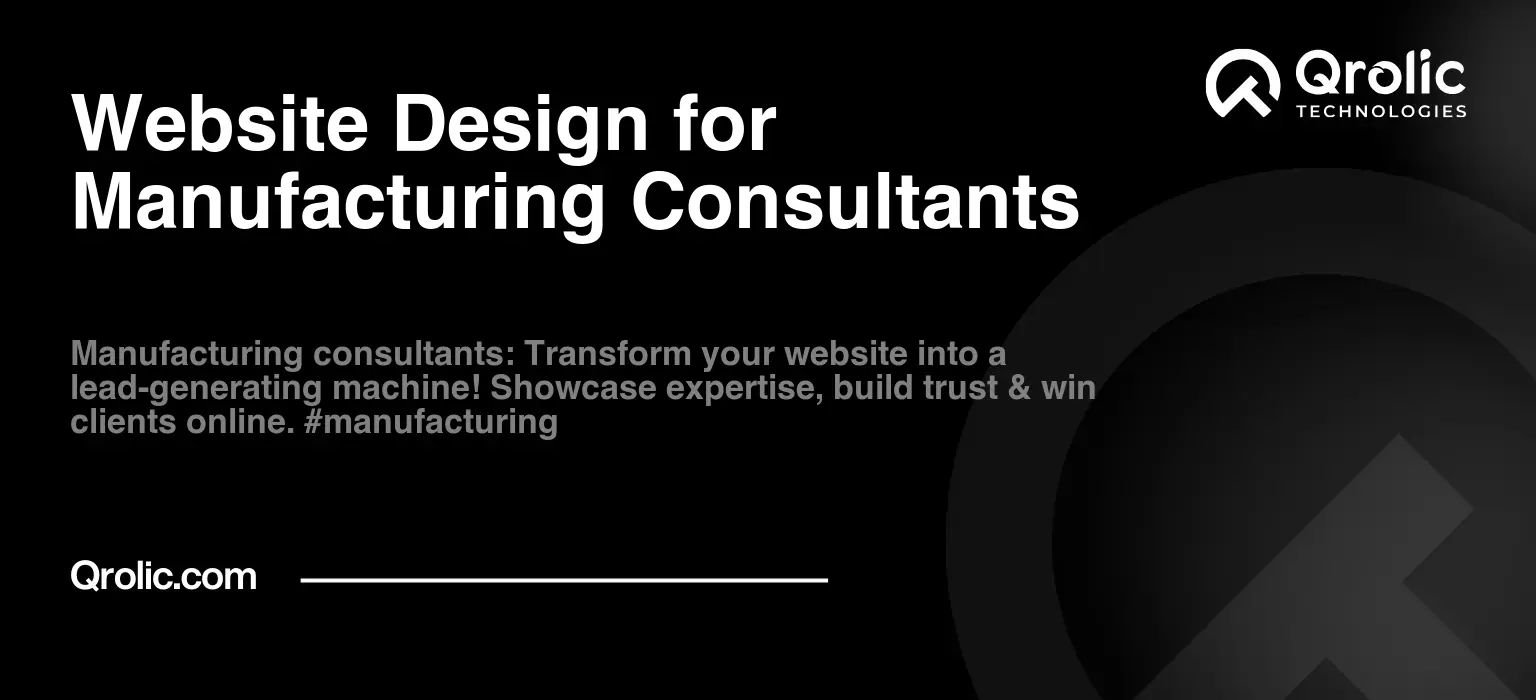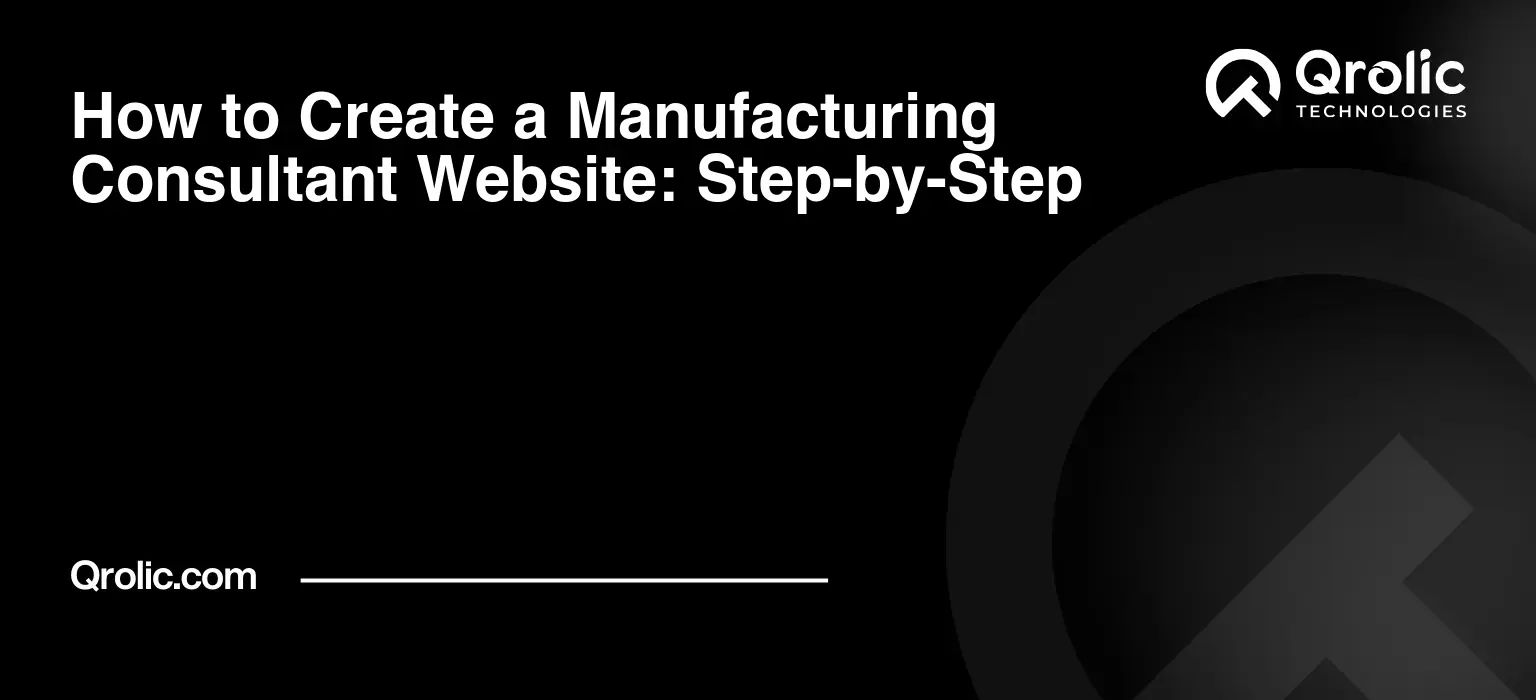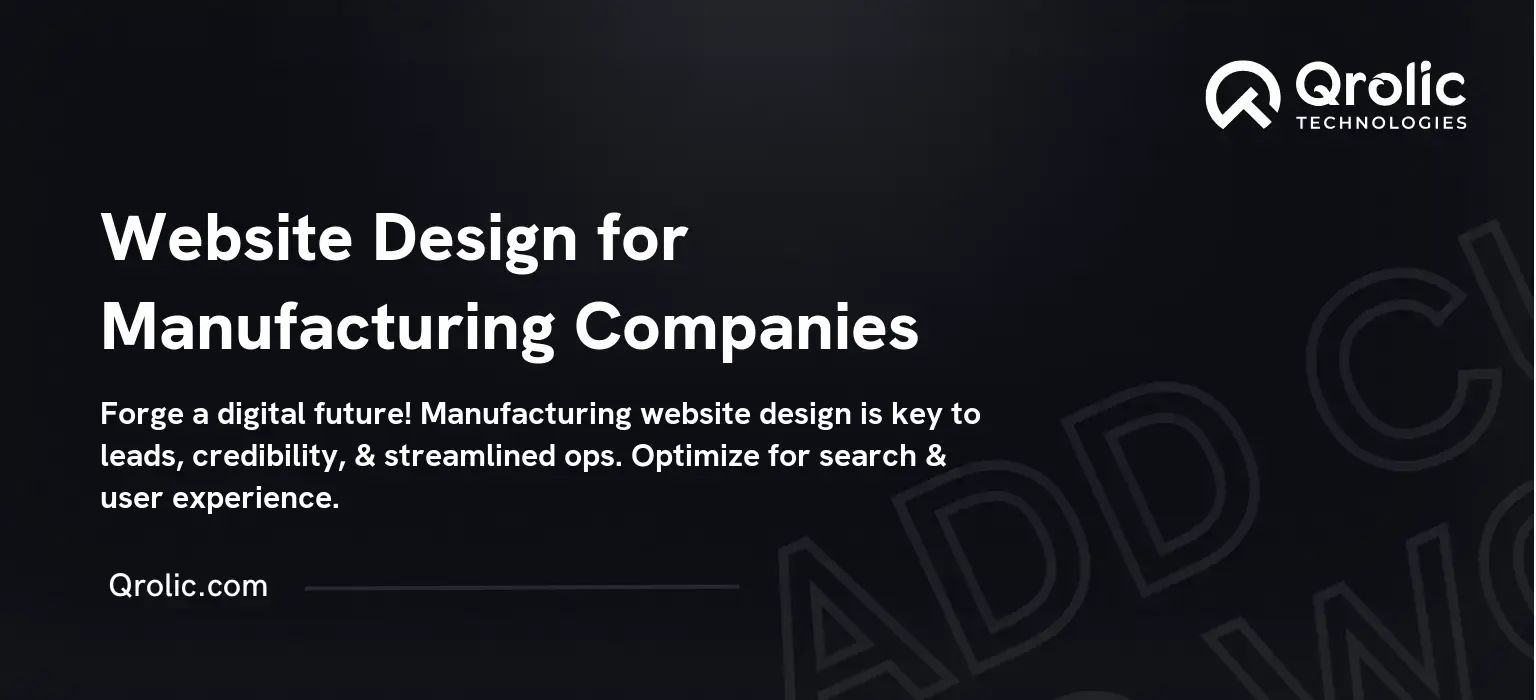Quick Summary:
- Your website is essential for attracting and converting clients.
- Clearly showcase your value, expertise, and successful results.
- Optimize your site for search engines and mobile devices.
- Track performance data to continuously improve and grow.
Table of Contents
- Why a Powerful Website is Non-Negotiable for Manufacturing Consultants
- The Shifting Sands of Client Acquisition: From Referrals to Online Discovery
- Beyond the Brochure: Your Website as a 24/7 Salesperson
- The Cost of Neglecting Your Online Presence: A Missed Opportunity
- Essential Elements of a High-Performing Manufacturing Consultant Website
- 1. Crystal-Clear Value Proposition: Addressing Their Pain Points
- 2. Compelling Visual Design: Projecting Professionalism and Trust
- 3. Showcasing Expertise: Building Credibility and Authority
- 4. Clear Call-to-Actions (CTAs): Guiding Visitors Towards Conversion
- 5. Search Engine Optimization (SEO): Making Your Website Discoverable
- 6. Contact Information and Easy Communication Channels: Making It Easy to Connect
- 7. Fast Loading Speed and Mobile-Friendliness: Enhancing User Experience
- 8. Data Analytics and Tracking: Measuring Performance and Making Improvements
- The Power of Content Marketing: Attracting and Engaging Your Target Audience
- Types of Content to Create:
- Content Promotion Strategies:
- Common Website Mistakes to Avoid:
- Qrolic Technologies: Your Partner in Manufacturing Consultant Web Development
- Our Expertise:
- Why Choose Qrolic Technologies?
- Measuring Your Website’s Success: Key Performance Indicators (KPIs)
- The Future of Manufacturing Consultant Websites: Trends to Watch
Why a Powerful Website is Non-Negotiable for Manufacturing Consultants
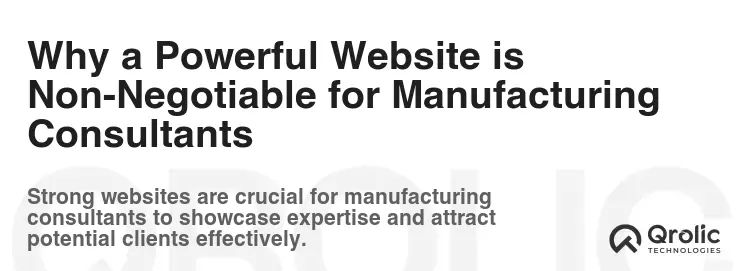
In today’s hyper-connected world, your website is often the first (and sometimes only) impression you make on potential clients. For manufacturing consultants, a professionally designed and strategically built website isn’t just an online brochure; it’s a powerful tool for lead generation, establishing credibility, and showcasing your expertise in a tangible way. It’s the digital handshake that sets the stage for lucrative partnerships.
The Shifting Sands of Client Acquisition: From Referrals to Online Discovery
Traditionally, manufacturing consulting relied heavily on word-of-mouth referrals. While referrals remain important, the landscape is shifting. Decision-makers are increasingly turning to online search to find consultants who can solve their specific challenges. If your website isn’t easily discoverable and doesn’t immediately convey your value proposition, you’re losing out on significant opportunities.
Think of it this way: a potential client is experiencing a bottleneck in their production line. They Google “improve manufacturing efficiency” or “lean manufacturing consultant.” If your website doesn’t appear in the search results, or if it looks outdated and unprofessional when it does, they’ll simply move on to the next option.
Beyond the Brochure: Your Website as a 24/7 Salesperson
A well-designed website acts as a tireless salesperson, working for you around the clock. It can:
- Attract qualified leads: Through targeted content and SEO optimization (more on that later!), your website can attract potential clients actively searching for solutions you provide.
- Establish credibility and trust: Showcase your experience, expertise, and successful track record through case studies, testimonials, and thought leadership articles.
- Educate potential clients: Explain complex manufacturing processes and your consulting methodologies in a clear and concise manner.
- Pre-qualify leads: Provide detailed information about your services, pricing models, and client requirements to ensure you’re only engaging with prospects who are a good fit.
- Streamline the sales process: Offer online booking for consultations, downloadable resources, and FAQs to answer common questions and move prospects further down the sales funnel.
The Cost of Neglecting Your Online Presence: A Missed Opportunity
The cost of neglecting your website is far greater than the investment required to build a professional one. You’re not just missing out on potential clients; you’re actively handing them over to your competitors. In a competitive market, a strong online presence is essential for survival and growth.
Essential Elements of a High-Performing Manufacturing Consultant Website
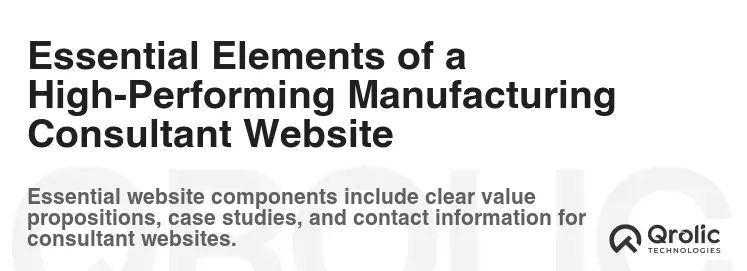
Now that we’ve established the why, let’s dive into the what and how. Here are the essential elements of a website designed to attract, engage, and convert manufacturing clients:
1. Crystal-Clear Value Proposition: Addressing Their Pain Points
Your website must immediately answer the question: “What can you do for me?” Don’t bury your value proposition in jargon or abstract language. Clearly and concisely communicate the specific problems you solve and the tangible benefits you deliver.
- Focus on their pain points: Understand the challenges your target audience faces (e.g., inefficiency, waste, regulatory compliance, lack of innovation) and tailor your messaging accordingly.
- Use benefit-driven language: Instead of saying “We offer process optimization,” say “We help you reduce production costs by 15% and increase throughput by 20%.”
- Highlight your unique selling proposition (USP): What makes you different from other manufacturing consultants? Is it your specialized expertise, your proven methodology, or your track record of success?
Example:
Instead of: “Experienced manufacturing consultants offering a wide range of services.”
Try: “Transform your manufacturing operations with our data-driven strategies. We specialize in lean manufacturing, Six Sigma, and Industry 4.0 solutions, helping you reduce waste, improve efficiency, and increase profitability.”
2. Compelling Visual Design: Projecting Professionalism and Trust
Visual design is crucial for creating a positive first impression and establishing credibility. Your website should look professional, modern, and trustworthy.
- Clean and uncluttered layout: Avoid overwhelming visitors with too much information or visual clutter. Use white space effectively to create a clean and easy-to-navigate design.
- High-quality photography and videography: Invest in professional photos and videos that showcase your work, your team, and your facilities. Avoid generic stock photos that look inauthentic.
- Consistent branding: Use your company logo, colors, and fonts consistently throughout the website to reinforce your brand identity.
- Mobile-responsive design: Ensure your website looks and functions flawlessly on all devices, including smartphones and tablets. Mobile-friendliness is also a key ranking factor for search engines.
- Intuitive navigation: Make it easy for visitors to find the information they’re looking for. Use clear and concise menu labels, logical page structure, and a prominent search bar.
3. Showcasing Expertise: Building Credibility and Authority
Demonstrate your expertise and build trust by sharing valuable insights and showcasing your successful track record.
- Case studies: Highlight specific projects you’ve completed, detailing the challenges, solutions, and results achieved. Use data and metrics to quantify the impact of your work.
- Testimonials: Feature testimonials from satisfied clients who can vouch for your expertise and professionalism. Video testimonials are particularly effective.
- Blog posts and articles: Share your knowledge and insights on relevant topics, such as lean manufacturing, supply chain management, or Industry 4.0. This will not only establish you as a thought leader but also improve your search engine ranking.
- White papers and ebooks: Offer downloadable resources that provide in-depth information on specific topics. This is a great way to generate leads and demonstrate your expertise.
- Team bios: Introduce your team members and highlight their qualifications, experience, and areas of expertise. This will help humanize your brand and build trust with potential clients.
Example Case Study Structure:
- Challenge: Briefly describe the problem the client was facing.
- Solution: Explain the strategies and methodologies you employed to address the challenge.
- Results: Quantify the impact of your work using data and metrics (e.g., “Reduced production costs by 15%,” “Increased throughput by 20%,” “Improved customer satisfaction by 10%”).
- Client Quote: Include a quote from the client expressing their satisfaction with your services.
4. Clear Call-to-Actions (CTAs): Guiding Visitors Towards Conversion
Every page of your website should have a clear call-to-action (CTA) that encourages visitors to take the next step, whether it’s contacting you for a consultation, downloading a resource, or subscribing to your newsletter.
- Use action-oriented language: Instead of saying “Contact Us,” say “Get a Free Consultation” or “Request a Quote.”
- Make your CTAs visually prominent: Use contrasting colors and strategically placed buttons to draw attention to your CTAs.
- Test different CTAs: Experiment with different wording and design to see which ones perform best.
- Offer value in exchange for contact information: Instead of simply asking visitors to “Contact Us,” offer a free assessment, a downloadable guide, or a personalized consultation in exchange for their contact information.
Examples of Effective CTAs:
- “Schedule a Free Manufacturing Process Audit”
- “Download Our Guide to Lean Manufacturing”
- “Request a Customized Proposal”
- “Talk to an Expert Today”
5. Search Engine Optimization (SEO): Making Your Website Discoverable
SEO is the process of optimizing your website to rank higher in search engine results pages (SERPs). This is crucial for attracting organic traffic from potential clients who are actively searching for manufacturing consultants.
- Keyword research: Identify the keywords and phrases that your target audience is using to search for manufacturing consultants (e.g., “lean manufacturing consultant,” “supply chain optimization,” “process improvement”). Use these keywords strategically throughout your website content.
- On-page optimization: Optimize your website’s content, meta tags, and URL structure for your target keywords.
- Off-page optimization: Build high-quality backlinks from other reputable websites in your industry. This will signal to search engines that your website is authoritative and trustworthy.
- Technical SEO: Ensure your website is technically sound and easy for search engines to crawl and index. This includes optimizing your website’s speed, mobile-friendliness, and site structure.
- Local SEO: If you serve a specific geographic area, optimize your website for local search. This includes creating a Google My Business listing and building citations from local directories.
Keyword Integration Tips:
- Use keywords naturally: Don’t stuff keywords into your content. Write in a clear and concise manner, and use keywords where they fit naturally.
- Focus on long-tail keywords: Long-tail keywords are longer, more specific phrases that people use when they’re closer to making a decision. Targeting long-tail keywords can help you attract more qualified leads.
- Use keywords in your headings and subheadings: This will help search engines understand the topic of each page.
- Use keywords in your image alt text: This will help search engines understand what your images are about.
- Monitor your keyword rankings: Track your keyword rankings in search engines to see how your SEO efforts are performing.
6. Contact Information and Easy Communication Channels: Making It Easy to Connect
Make it easy for potential clients to contact you. Provide clear and prominent contact information on every page of your website.
- Phone number: Display your phone number prominently at the top of every page.
- Email address: Provide a professional email address (e.g., info@yourcompany.com).
- Contact form: Include a contact form on your contact page that allows visitors to easily submit inquiries.
- Live chat: Consider adding live chat to your website to provide instant support to visitors.
- Social media links: Include links to your social media profiles.
- Map integration: If you have a physical office location, embed a Google Map on your contact page.
7. Fast Loading Speed and Mobile-Friendliness: Enhancing User Experience
A slow-loading website will frustrate visitors and hurt your search engine ranking. Make sure your website loads quickly and is optimized for mobile devices.
- Optimize images: Compress your images to reduce their file size without sacrificing quality.
- Use a content delivery network (CDN): A CDN will distribute your website’s content across multiple servers, ensuring that it loads quickly for visitors from anywhere in the world.
- Minimize HTTP requests: Reduce the number of HTTP requests your website makes by combining CSS and JavaScript files and using CSS sprites.
- Enable browser caching: Browser caching allows visitors’ browsers to store static content, such as images and CSS files, so that they don’t have to be downloaded every time they visit your website.
- Test your website’s speed: Use tools like Google PageSpeed Insights to test your website’s speed and identify areas for improvement.
8. Data Analytics and Tracking: Measuring Performance and Making Improvements
Use data analytics to track your website’s performance and identify areas for improvement.
- Google Analytics: Install Google Analytics on your website to track key metrics, such as traffic, bounce rate, conversion rate, and time on site.
- Conversion tracking: Set up conversion tracking to track the number of leads and sales generated by your website.
- A/B testing: Use A/B testing to experiment with different website elements, such as headlines, CTAs, and images, to see which ones perform best.
- Regularly review your data: Analyze your website’s data on a regular basis to identify trends and insights that can help you improve your website’s performance.
The Power of Content Marketing: Attracting and Engaging Your Target Audience
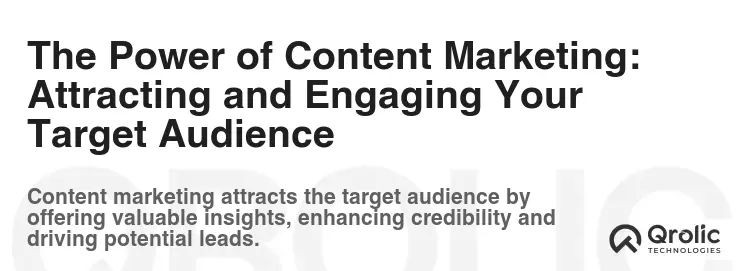
Content marketing is a powerful strategy for attracting and engaging your target audience. By creating and sharing valuable, informative, and engaging content, you can establish yourself as a thought leader, build trust with potential clients, and generate leads.
Types of Content to Create:
- Blog posts: Share your insights on relevant topics, such as lean manufacturing, supply chain management, or Industry 4.0.
- Case studies: Highlight specific projects you’ve completed, detailing the challenges, solutions, and results achieved.
- White papers and ebooks: Offer downloadable resources that provide in-depth information on specific topics.
- Infographics: Create visually appealing infographics that present complex data in an easy-to-understand format.
- Videos: Create videos that showcase your work, your team, and your facilities.
- Podcasts: Host a podcast that features interviews with industry experts and discussions on relevant topics.
Content Promotion Strategies:
- Share your content on social media: Promote your content on social media platforms like LinkedIn, Twitter, and Facebook.
- Email marketing: Send out email newsletters that feature your latest content.
- Guest blogging: Write guest posts for other websites in your industry.
- Paid advertising: Use paid advertising to promote your content to a wider audience.
Common Website Mistakes to Avoid:
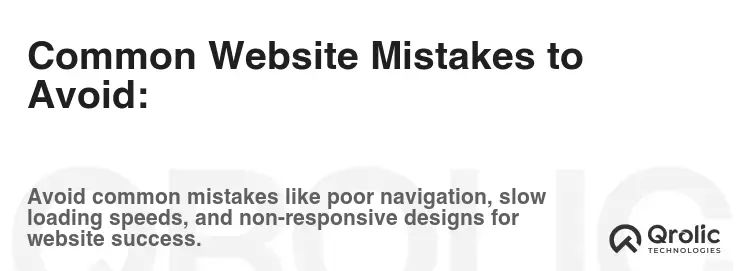
- Outdated design: An outdated website design will make your company look unprofessional and untrustworthy.
- Poor navigation: A confusing or difficult-to-navigate website will frustrate visitors and drive them away.
- Slow loading speed: A slow-loading website will frustrate visitors and hurt your search engine ranking.
- Lack of mobile-friendliness: A website that is not optimized for mobile devices will provide a poor user experience for mobile visitors.
- Poor quality content: Content that is poorly written, inaccurate, or irrelevant will damage your credibility.
- Lack of clear calls to action: A website that lacks clear calls to action will fail to convert visitors into leads.
- Ignoring SEO: A website that is not optimized for search engines will not be easily discoverable by potential clients.
Qrolic Technologies: Your Partner in Manufacturing Consultant Web Development
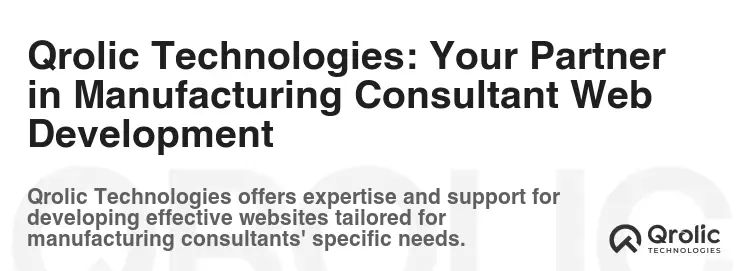
At Qrolic Technologies, we understand the unique needs of manufacturing consultants and the importance of a strong online presence. We specialize in industrial consulting web development, creating custom websites that attract, engage, and convert leads. We help manufacturing businesses establish a professional and effective online presence.
Our Expertise:
- Custom website design: We create custom websites that are tailored to your specific needs and brand identity.
- Responsive design: We ensure your website looks and functions flawlessly on all devices, including smartphones and tablets.
- SEO optimization: We optimize your website for search engines to help you attract organic traffic.
- Content marketing: We help you create and promote valuable content that attracts and engages your target audience.
- E-commerce solutions: If you sell products or services online, we can help you create a secure and user-friendly e-commerce website.
- Ongoing support and maintenance: We provide ongoing support and maintenance to ensure your website is always up-to-date and functioning properly.
Why Choose Qrolic Technologies?
- Industry expertise: We have extensive experience working with manufacturing consultants and understand the challenges they face.
- Customized solutions: We don’t believe in one-size-fits-all solutions. We work closely with you to create a website that meets your specific needs and goals.
- Results-driven approach: We are committed to delivering results that help you grow your business.
- Transparent communication: We keep you informed throughout the entire web development process.
- Affordable pricing: We offer competitive pricing to fit your budget.
Let Qrolic Technologies help you create a website that positions you as a leader in the manufacturing consulting industry. Contact us today for a free consultation. Visit us at https://qrolic.com/.
Measuring Your Website’s Success: Key Performance Indicators (KPIs)
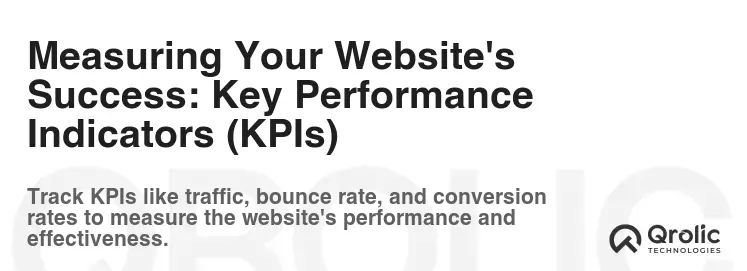
After launching your website, it’s crucial to track its performance and measure its success. Key Performance Indicators (KPIs) provide valuable insights into how well your website is achieving its goals and identify areas for improvement.
Here are some essential KPIs to track for your manufacturing consultant website:
- Website traffic: The total number of visitors to your website. This indicates the overall visibility and reach of your website.
- Traffic sources: Where your website traffic is coming from (e.g., organic search, paid advertising, social media, referrals). This helps you understand which marketing channels are most effective.
- Bounce rate: The percentage of visitors who leave your website after viewing only one page. A high bounce rate may indicate that your website content is not engaging or that your website is difficult to navigate.
- Time on site: The average amount of time visitors spend on your website. This indicates the level of engagement with your website content.
- Conversion rate: The percentage of visitors who take a desired action, such as filling out a contact form, downloading a resource, or requesting a quote. This is a key indicator of your website’s ability to generate leads.
- Cost per lead (CPL): The cost of acquiring a lead through your website. This helps you measure the ROI of your website and marketing efforts.
- Customer acquisition cost (CAC): The total cost of acquiring a new customer, including website development, marketing, and sales expenses. This is a critical metric for understanding the profitability of your business.
- Keyword rankings: The position of your website in search engine results pages (SERPs) for your target keywords. This indicates the effectiveness of your SEO efforts.
- Return on investment (ROI): The overall return on your investment in your website and marketing efforts. This is the ultimate measure of your website’s success.
By tracking these KPIs and analyzing your website’s data, you can gain valuable insights into how to improve your website’s performance and achieve your business goals. Remember to regularly review your data and make adjustments to your website and marketing strategies as needed.
The Future of Manufacturing Consultant Websites: Trends to Watch
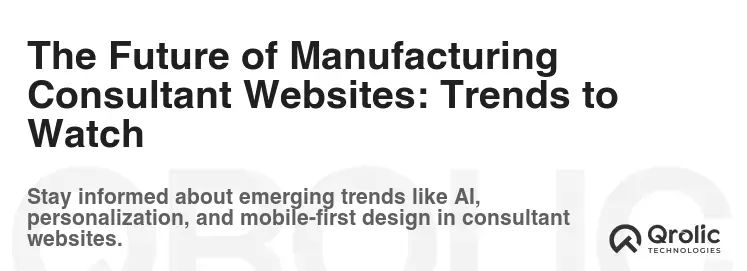
The digital landscape is constantly evolving, and it’s important to stay up-to-date on the latest trends in website design and technology. Here are some trends to watch in the future of manufacturing consultant websites:
- Artificial Intelligence (AI): AI is being used to personalize website content, provide chatbots for customer support, and automate marketing tasks.
- Virtual Reality (VR) and Augmented Reality (AR): VR and AR are being used to create immersive experiences that allow potential clients to virtually tour manufacturing facilities and visualize solutions.
- Voice Search Optimization: As voice search becomes more popular, it’s important to optimize your website for voice search queries.
- Data-Driven Personalization: Websites are becoming increasingly personalized based on user data, such as location, browsing history, and demographics.
- Emphasis on User Experience (UX): User experience is becoming increasingly important, as websites strive to provide seamless and intuitive experiences for visitors.
- Sustainability and Ethical Design: There’s a growing focus on creating sustainable and ethically designed websites that minimize their environmental impact.
By staying informed about these trends and incorporating them into your website strategy, you can ensure that your website remains competitive and effective in the years to come.
In conclusion, a well-designed and strategically built website is an indispensable asset for manufacturing consultants. By focusing on clear value propositions, compelling visual design, showcasing expertise, clear calls-to-action, SEO optimization, and ongoing data analysis, you can create a website that attracts, engages, and converts potential clients, driving growth and success for your consulting business. Don’t underestimate the power of a strong online presence in today’s competitive market.
